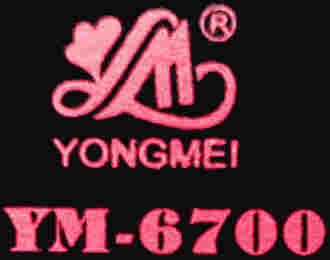
 |
stinking keyboard with realtime programmable rhythm & trashy orchestrion accompaniment |
Despite Yongmei's transistor tooter age is over (see Golden Camel 7A), they still makes the definitely worst built keyboards I ever saw! While the concept and operation of this sample based fullsize tablehooter from 2002 (printed PCB date) is like a normal modern sound bank keyboard, 2 severe flaws make it almost unusual - in new state it stinks unbearable acrid and always a very disturbing loud static noise of fixed pitch mixes into all sounds (unless you modify it). It also has only 29 instead of pretended 100 preset sounds; the rest is simply identical to fraud customers. But the ancient fairground organ accompaniment styles are lovely.
 |
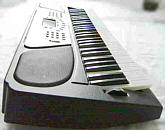 |
I also really don't understand why Yongmei decided to annoy their customer with fake duplicate preset sounds to pretend a modern 100 sound bank; even when there was really too little memory left to store more samples or 100 individually programmed presets, they should at least have filled the rest with algorithmically generated envelope variants of the given sounds. The older(?) Yongmei YM-2100 did this without problem, which was much more honest and useful.
The preset sounds and rhythms are made from slightly dull medium resolution samples those theoretically wouldn't sound that bad when there wouldn't be the annoying digital noise. There is a sustain and vibrato button and even a pitchbend wheel, although the latter responds a bit slow and has fairly low step resolution. The percussion is made from medium low resolution samples; the keyboard percussion mode has 61 sounds including various strange effect sounds those may be nice for tekkno; 8 of them are also playable through drumpad buttons. The 20 preset rhythms have each intro, fill-in and ending and there is a programmable rhythm pattern. The accompaniment styles are quite complex arranged but unfortunately accept only standard chords; many patterns have a lovely cheesy fairground organ style, which sounds wonderfully trashy when the bit resolution is reduced with the digital volume control. There is also a realtime programmable drum pattern (not combinable with accompaniment) and a polyphonic record/ playback sequencer.
Attention: On eBay there are often false claims that the Yongmei YM-6700 would have velocity sensitive keys and/ or 1000 preset sounds (which formerly was also claimed on the Yongmei site). This is definitely wrong; at least my specimen has no velocity and far less than 100 preset sounds. Also the writing "61-keys Teaching Electronic Keyboard" means nothing since (unlike DL-2300 or YM-3300) there are no dedicated play training features built in.
This keyboard was also released in a silver version.
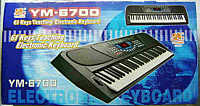 |
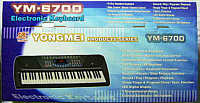 |
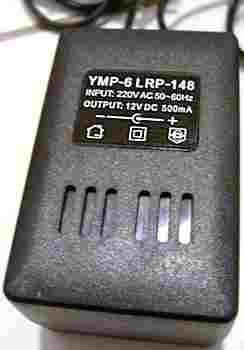 |
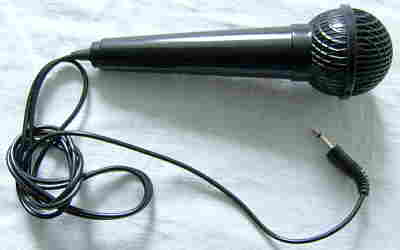 |
 |
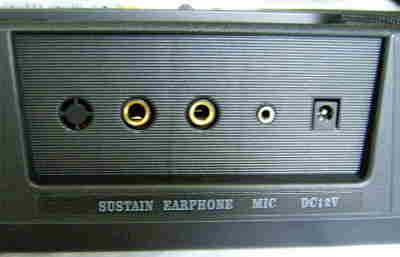 |
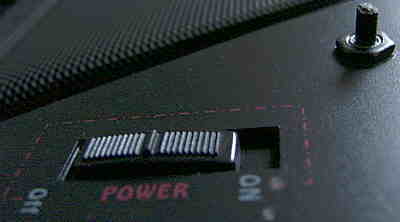 |
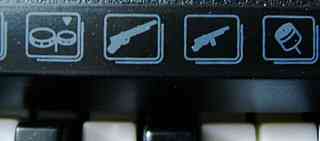
|
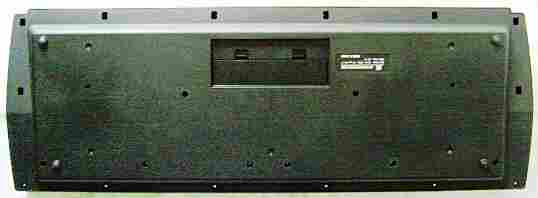
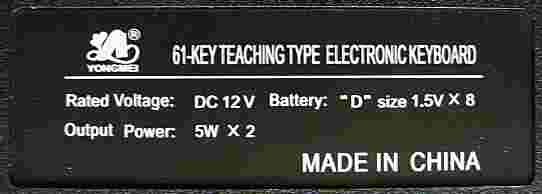 |
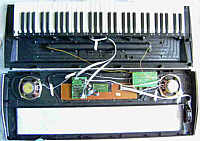 |

|
 |
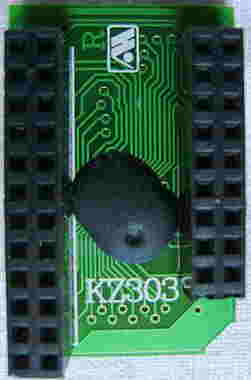 |
 |
 |
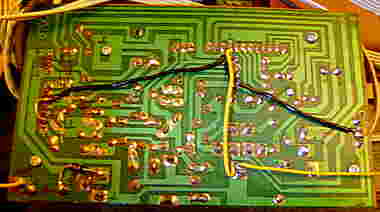 |
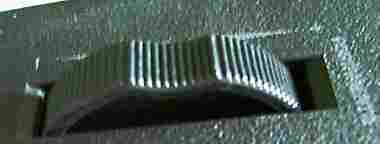
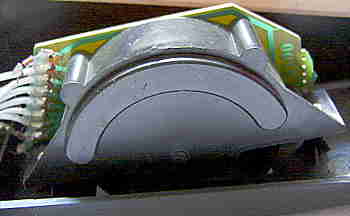 |
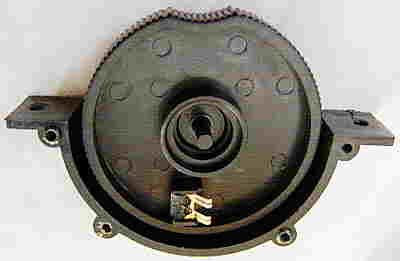
|
The pitchbend wheel uses no potentiometer, which is quite unusual. |
The case of the Yongmei YM-6700 is annoyingly
oversized and was likely inspired by modern bulky brand keyboards, but
at least it is fairly robust and heavy and has little common with the flimsy
thin plastic of other Yongmei tablehooters. On the back are even 2 golden
6.3mm jacks those look much more professional than the wacky 3.5mm jacks
of other Yongmeis. Also the loudspeakers don't appear that cheap; they
make enough bass and don't excessively distort, although they were likely
rather designed to play loud than natural because they sound somewhat dull
and have a tubby midrange resonance that makes loud play unpleasant. Even
the electronics looks mechanically similarly well constructed like in newer
Yamaha
or Casio keyboard and has nothing common with the horrible wire
mess inside older Yongmei tablehooters (see e.g. Golden
Camel-11AB or MeiKe
MK-320B); the digital part here is a multi- chip
PCB and the power amplifier even has a big heatsink, thus I think it was
made in a different factory. Only the Engrish misspellings in the sound
and rhythm list hint where this keyboard came from. But the clean looking
hardware design did not prevent the digital key matrix signals from leaking
into the amplifier, which mixes a very disturbing tooting noisy tone of
fixed pitch into all sounds and makes the instrument almost unbearable. 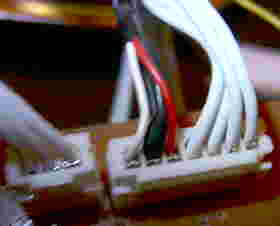 There
is also some mains hum. In my specimen the internal audio cable between
main and amp PCB was plugged in wrongways, thus instead of the audio signal
the supply voltage lines got the shielded leads, but re-plugging it correctly
didn't help much. Also the range of the volume control was so badly chosen
that the lowest setting was still too loud although it reduces the sample
bit resolution badly. I added an analogue volume potentiometer to turn
down both to a bearable level, which also reduces the key matrix noise,
but the noise still toots too loud despite I have rewired various GND lines.
Like with
Yongmei YM-3300 the
LED display after 3 seconds always returns to the tempo setting instead
of showing the currently selected preset sound or rhythm number, although
here this disturbs a bit less because the YM-6700 has separate pilot LEDs
for various buttons (only the "vibrato" one was forgotten) and buttons
don't beep when you press "timbre" or "rhythm" to see their number. The
tooting key matrix noise turns the louder, the more LED display segments
are lit, thus there is possibly a design flaw in the sound chip that causes
the pulsed display current to modulate its audio output voltage. (Perhaps
it will help to insert a driver IC into the display output lines to reduce
the display current, but I haven't examined the hardware further yet.) There
is also some mains hum. In my specimen the internal audio cable between
main and amp PCB was plugged in wrongways, thus instead of the audio signal
the supply voltage lines got the shielded leads, but re-plugging it correctly
didn't help much. Also the range of the volume control was so badly chosen
that the lowest setting was still too loud although it reduces the sample
bit resolution badly. I added an analogue volume potentiometer to turn
down both to a bearable level, which also reduces the key matrix noise,
but the noise still toots too loud despite I have rewired various GND lines.
Like with
Yongmei YM-3300 the
LED display after 3 seconds always returns to the tempo setting instead
of showing the currently selected preset sound or rhythm number, although
here this disturbs a bit less because the YM-6700 has separate pilot LEDs
for various buttons (only the "vibrato" one was forgotten) and buttons
don't beep when you press "timbre" or "rhythm" to see their number. The
tooting key matrix noise turns the louder, the more LED display segments
are lit, thus there is possibly a design flaw in the sound chip that causes
the pulsed display current to modulate its audio output voltage. (Perhaps
it will help to insert a driver IC into the display output lines to reduce
the display current, but I haven't examined the hardware further yet.) |
Bright notes often hiss unpleasantly harsh because the sounds either contain strong DAC aliasing noise or intermodulate with the key matrix noise. Possibly as a questionable attempt to fix this, the highest octave in some preset sounds employs a keysplit zone with a too dull sample. The preset sounds are made from medium resolution loop samples; many timbres remind to Hammond organ sounds. Due to most samples employ no split zones, the bass range of many sounds is unrealistic; e.g. some wind instruments grunt with very slow attack by the too slow sample playback frequency. Sounds with built-in sustain ignore the sustain button. The length of added sustain depends on the preset sound. Nice is that when a key is trilled with sustain, each new note occupies a new sound channel, which produces a great phasing sound and volume increase effect although this eats up polyphony. The vibrato button adds a weak 5Hz vibrato. Both buttons also affect held notes (selecting a preset sound doesn't). Unusual is that the pitchbend wheel (called "Gliss Wheels" in the Engrish manual) moves instead of a potentiometer a digital multi- contact switch, which may be less wear prone (the remotely similar Sankai 01504H still had a custom made pot). But this construction also reduces the resolution to 5 steps per direction and makes the pitchbend respond a little slow. Slowly bending down even makes the pitch jump up again between the steps. The wheel also sometimes gets stuck , thus it works in no way better than a cheap pot. Like with Yongmei DL-2300 the preset sounds have lots of fancy fantasy names but most sounds resemble not remotely what their name suggests and many preset sounds are simply identical to fraud the customer; I have listed these doublets separately.
The "Grand Piano" sounds quite realistic in mids and high notes, but by the lack of split zones the bass range is a bit too dull and resembles rather a well synthesized FM piano. (Yongmei YM-3300 has a better piano.) "Bright Piano" is an e-piano with Hammond organ timbre and weak tremolo in the quite dull bass range; high notes (2nd split zone) are dull. "Elect Piano1" has an even duller timbre that turns quieter with high notes. 2 has slower attack and a kind of duophonic e-bass or hollow nylon guitar timbre in mid and low notes; low notes are very dull. "Honky-Tonk" is no piano at all but sounds like a reedy wood pipe organ timbre with halfway buzzy bass. "Flat Piano2" is also no piano but sounds like an oboe or bassoon; higher notes resemble a metal flute. "Organ" has pipe organ envelope (slow attack) on the same organ timbre like "Bright Piano". "Percussive Organ" sounds like a xylophone but doesn't decay. "Church Organ" is a metal pipe organ rank with sonorous bass range. "Reed Organ" is a pipe organ timbre with dull bass range (not accordion- like); "Accordion" is another pipe organ with buzzier bass range, but the bass is far too dull and the sound too fat to sound realistic. "String1" sounds like a slightly harsh french horn timbre which slowly fades louder with some zipper noise and has sustain. "String2" is another piano made from the "Honky-Tonk" waveform with piano envelope. "Violin" sounds halfway realistic; it has a scratchy attack phase and no vibrato; in the bass range the attack of the sample turns too slow and thus unrealistic. "Pizzicato String" is a fast decaying synth brass sound using the "Strings1" waveform; high notes remind to a steel drum. "Synth String2" is a sort of vibraphone (without vibrato) that quickly howls down during its sampled attack phase. "Tremoto String" is a dull synth vibraphone with sustain and a very strong 7Hz square vibrato, that jumps up and down by an entire semitone. It resembles much the lovely "ghost" sound on various Bontempi keyboards. "French Horn" sounds with mid notes halfway realistic; high notes sound like a piccolo flute and low notes are noisy and too dull with slow attack. "Trumpet" sounds quite realistic (like with Yongmei DL-2300); bass range resembles a tuba. "Calliope" is another organ timbre; it resembles a dull metal pipe organ rank and has semi- percussive attack (timbre is a duller "French Horn" variant). "Flute" sounds fairly realistic like a metal flute with wind noise during attack; low notes growl dull with too slow attack. "Synth Brass2" resembles in the bass range a dull e-bass and with mid and high notes a sort of e-piano. "Synth Brass3" is a variant of "Pizzicato Strings" with "French Horn" timbre. "Wood Pipe1" sounds like a xylophone; 2 is the same sample with more compact envelope and stronger clicking attack (perhaps a marimba). "Recorder" is instead of a flute a fast decaying dull picked string or steel drum. "Jazz Guitar" sounds like a mandolin (fast decay, doesn't ring). "Yang Qin" is the xylophone "Synth String2" with sustain. "Metal1" decays fast (like a picked string) with "Church Organ" timbre.
doublets (identical sounds):
| 00 | Grand Piano | = #07 Clavinet, #51 Electronic Guitar, #80 Celesta | |
| 01 | Bright Piano | = #08 Harpsichord1, #52 Clean Guitar, #81 Marimba, #87Tubular Bell | |
| 02 | Elect Piano1 | = #09 Harpsichord2, #59 Mandolin, #83 Dulcimer | |
| 03 | Elect Piano2 | = #05 Flat Piano1, #42 Bottle wood Pipe1 | |
| 04 | Honky-Tonk | = #15 French Organ, #23 Viola, #25 String Ensemble2, #57 Steel Guitar, #71 Synth Bass2, #75 Rock Bass, #78 Overdriven Bass1, #96 Metal2 | |
| 06 | Flat Piano2 | = #16 Harmonica, #56 Overdriven Guitar, #84 Bell | |
| 10 | Organ | = #17 Drawbar Organ | |
| 11 | Percussive Organ | = #88 Glocknspiel | |
| 12 | Church Organ | =#19 Rock Organ, #27 Synth String1, #73 Jazz Bass4 | |
| 13 | Reed Organ | ||
| 14 | Accordion | = #18 Jazz Organ | |
| 20 | String1 | = #24 String Ensemble1, #70 Synth Bass1, #98 Bowed | |
| 21 | String2 | = #37 Synth Brass1, #50 Piano Guitar, #63 Soprano Saxophone, #67 Oboe, #79 Overdriven Bass2 | |
| 22 | Violin | = #72 Synth Bass3 | |
| 26 | Pizzicato String | = #55 Rock Guitar, #77 Picked Bass | |
| 28 | Synth String2 | = #74 Acoustic Bass, #89 Vibraphone, #93 Synth1 | |
| 29 | Tremoto String | = #53 Harmonic Guitar, #76 Finger Bass, #86 Musix Box, #90 Fantasia, #99 Science Fiction | |
| 30 | French Horn | = #32 Tuba, #60 Baritone Saxophone, #64 Jazz Saxophone, #92 Holo Pad | |
| 31 | Trumpet | = #35 Charang, #62 Alto Saxophone, #68 English Horn | |
| 33 | Calliope | = #36 Square Wave, #46 Ocarina, #66 Clarinet | |
| 34 | Flute | = #48 Synth wood Pipe2, #61 Tenor Saxophone, #69 Bassoon | |
| 38 | Synth Brass2 | = #47 Synth wood Pipe1, #54 Muted Guitar, #91 Warm Pad | |
| 39 | Synth Brass3 | = #44 Bottle wood Pipe3, #49 Synth wood Pipe3, #65 Synth Saxophone | |
| 40 | Wood Pipe1 | = #43 Bottle wood Pipe2 | |
| 41 | Wood Pipe2 | = #82 Xylophone | |
| 45 | Recorder | ||
| 58 | Jazz Guitar | ||
| 85 | Yang Qin | = #94 Synth2, #97 Crystal | |
| 95 | Metal1 |
The percussion is made from medium resolution samples those like the rest of the keyboard play rather bassy. Unlike Yongmei YM-3300 here also the keyboard percussion mode is real and indeed has one sound per key. Some sounds are re-used for 3 or 4 pitch variants, but this is nothing bad. Unfortunately the pitchbend wheel does not take effect on them. Beside normal standard and latin drumkit percussion there are also some nice synth toms, synth zaps, strange shakers and grainy gun shot and explosion noises those may be great for tekkno. Like everything else also the percussion is mixed with the annoying key matrix beep noise, although for tekkno this even may be suitable as a sound effect.
 |
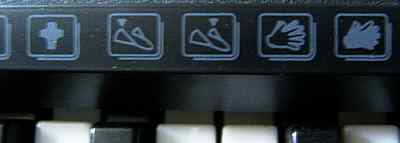 |
The accompaniments are nicely arranged and some have a cheesy organ staccato chord line that sounds like an ancient orchestrion or fairground organ. Some have complex walking bass patterns and grooving bass (boogie woogie style) while others are less orchestrated and more versatile. But generally they sound nicely trashy and fulfil the tablehooter cliché in a positive way. It has so stereotypical old fashioned intro, fill-in and ending patterns that they sound like from an old cartoon or comedy movie or like some odd kind of circus band. I yet never found another keyboard with only that kind of oldie accompaniments. During fill-in the accompaniment pattern continues. Unfortunately the fingered accompaniment recognizes only standard establishment chords and ignores other key presses. (Yongmei YM-2100 and DL-2300 did this much better.) Odd is only that in fingered chord mode single finger presses trigger minor chords (with most such keyboards they do nothing). But there seem to be also various small glitches those make the patterns sound special; e.g. in some accompaniments they are selected by the currently played chord (not by chord changes). Depending on the selected rhythm, the accompaniments use different sounds, but usually there is an organ chord with more or less grunting bass and everything has a nice dose of analogue distortion (like from an old Hammond organ). But there is no manual chord mode without rhythm.
The demo melodies are mainly polyphonic piano tracks, but their names are not listed in the manual.
The 5 demo melodies are:
A close variant of this keyboard with only 20 (claimed) preset sounds
was released as Yongmei YM-6600 (aka Cronenwerth CEK-660,
slightly different control panel, silver case).
| removal of these screws voids warranty... | ||
 |
||
|
|